An 8th-century settlement home to a captivating old town, Fez combines ancient traditions with an increasing appeal as a tourist destination.
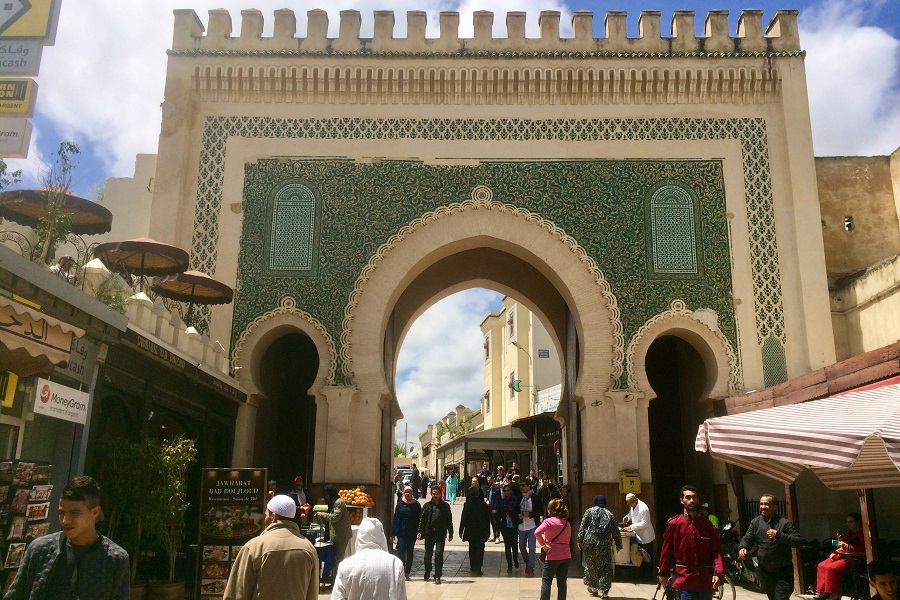
Bab Bou Jeloud, also known as ‘The Blue Gate’ (Photo: Andrea Gambaro)
A former Imperial city, Fez has long been known as Morocco’s artisanal, cultural and spiritual capital, home to outstanding Moorish architecture and to what some historians consider the world’s oldest university. Today, its medina (old town) is a 540-acre UNESCO site alive with crafts and customs which have changed little since medieval times, while a new wave of guest houses and restaurants showcase the pleasures of Moroccan hospitality.
The medina
Bab Bou Jeloud is the main access to Fes el-Bali, the original walled town. Once inside, the first encounter with the labyrinthine network of alleyways can be an immersive and fascinating experience.
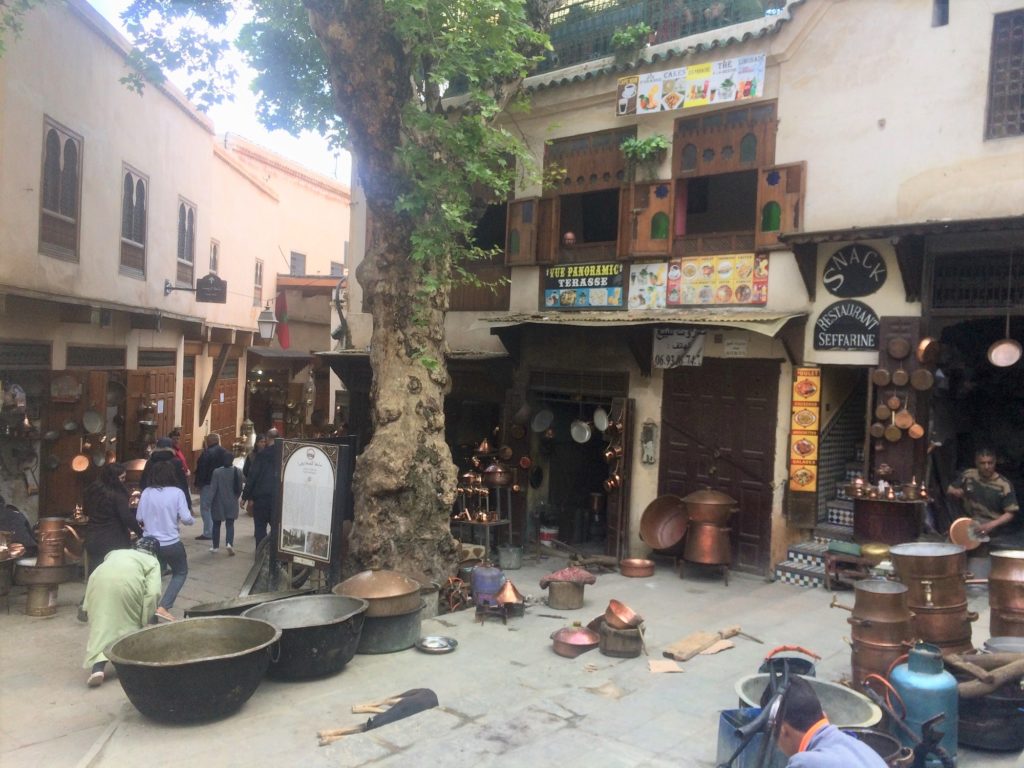
Place Seffarine can be easily found by following the sound of metalworkers (Photo: Andrea Gambaro)
The main lanes are lined with shops, workshops and food stalls, displaying a dazzling variety of products rousing the senses with scents, sounds, colours, textures and patterns. The occasional shout warns the crowd of the imminent passage of a cart or a pack donkey, the only means of conveyance in the car-free medina. Narrower side streets and irregularly-shaped squares constantly encourage stopovers or detours, and a hint of indecision may suffice for a local passerby to offer guidance (which often implies an expected tip, or baksheesh, in return).
Some might find it a little overwhelming at first, but it doesn’t take long to attune to the hustle and bustle of the medina and follow its flow to seek out the main attractions. These include the souks (markets), the tanneries, religious architecture, neglected funduqs (caravanserais) and stunning courtyards decorated with zellige mosaics and carved plaster-work.
When in need of a break, the many cafes, rooftop terraces and hidden gardens scattered all over provide a wide choice of quiet and relaxing hideouts.
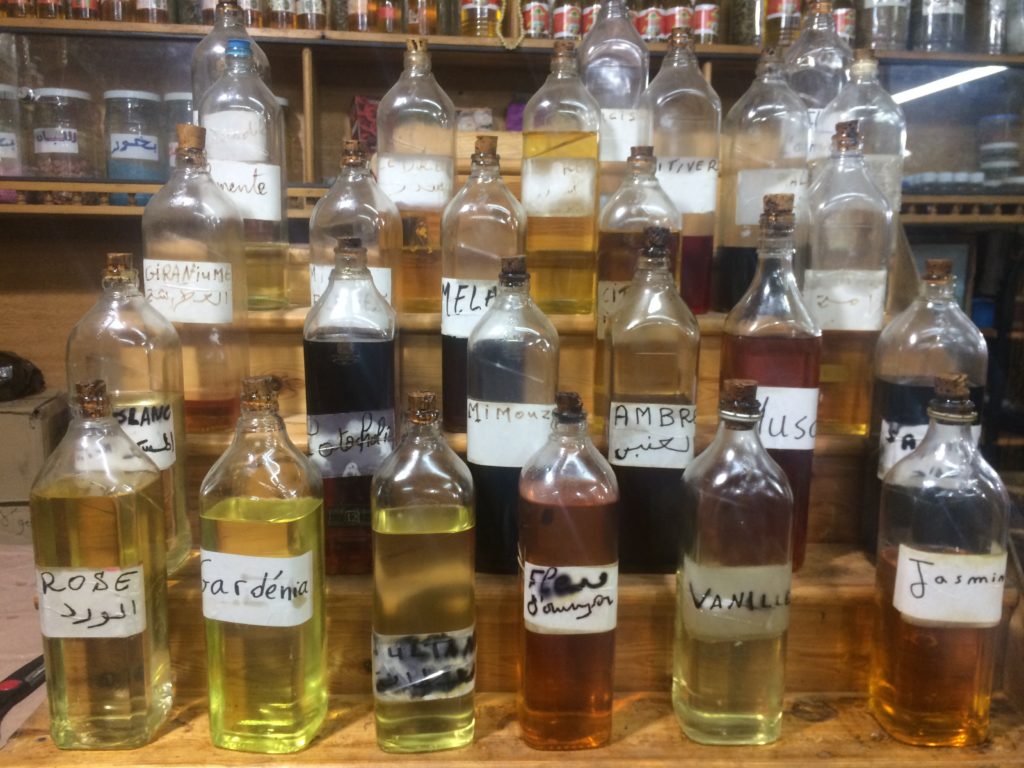
A typical display in a Berber pharmacy (Photo: Andrea Gambaro)
Popular attractions
The Chaouwara tanneries are Fez’s most popular sight, offering visitors an overview of ancient leather-dyeing techniques which are used today as they were centuries ago. A pungent smell fills the air as water wheels creak, hides hang to dry and workers bustle about the multi-chromatic dye tanks. The tour usually takes place on the terraces surrounding the site, but with some luck it is possible to get a closer look. In both cases, visitors are accompanied by local guys who will ask for a tip at the end of the tour. If looking for an up-close visit, the smaller and less touristy tanneries of Fez might be a better option.
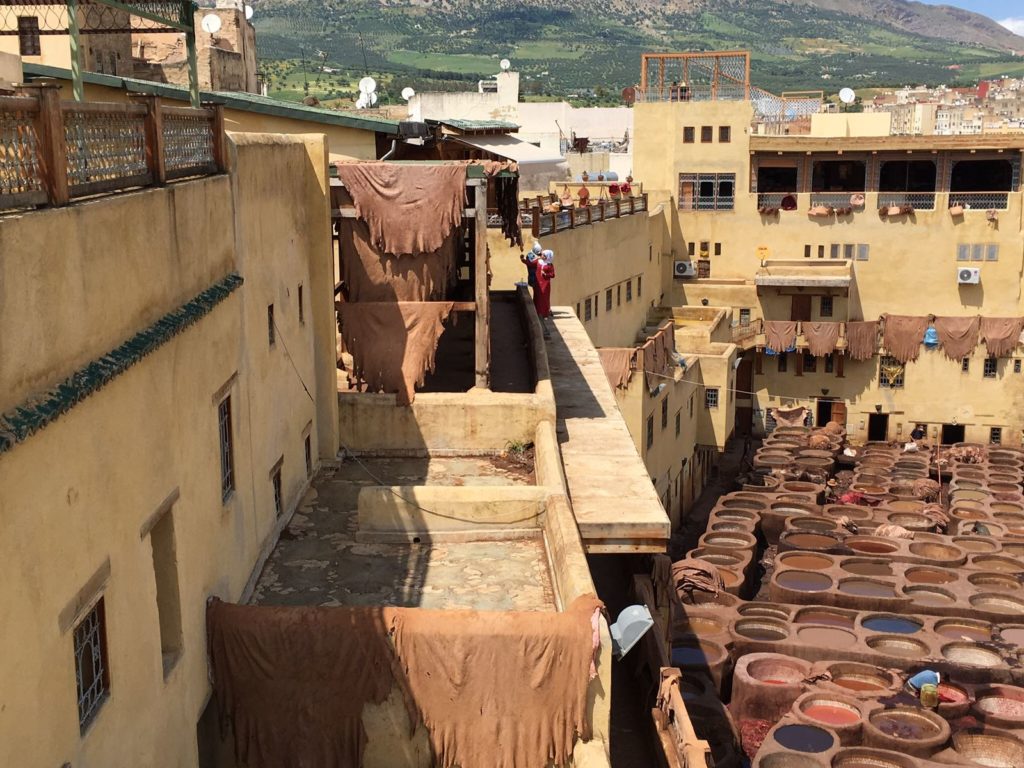
The Chaouwara Tanneries (Photo: Aina Pomar)
Founded in 859, Kairaouine is one of Africa’s largest mosques and said to be the world’s oldest university (although this is a matter of historical debate). Entrance is limited to Muslims, so visitors can either take a look at the courtyard from the door on Derb Boutouil or find a vantage point in the surrounding streets. The old library has been restored, but is currently open only to local students. Another popular religious site is the tomb of Moulay Idriss II, who founded Fez for the second time in 810. Again, entrance is prohibited but the view from outside the doors is worth the detour.
What can be fully visited are the medersas (religious colleges), whose courtyards boast finely-carved plaster, woodwork, stunning mosaics and impressive brass doors. Bou Inania is one of the best examples of Moorish architecture in town, while Al Attarine and Sahij are also popular with visitors.
A restored funduq, the Nejjarine is a museum of wooden arts and crafts; the building alone would be worth a visit, but the site also offers a beautiful collection of traditional items and a panoramic rooftop cafe. Another interesting building is Palais Glaoui, an 18th-century palace showing architectural grandeur and Andalusian design below a patina of decay.
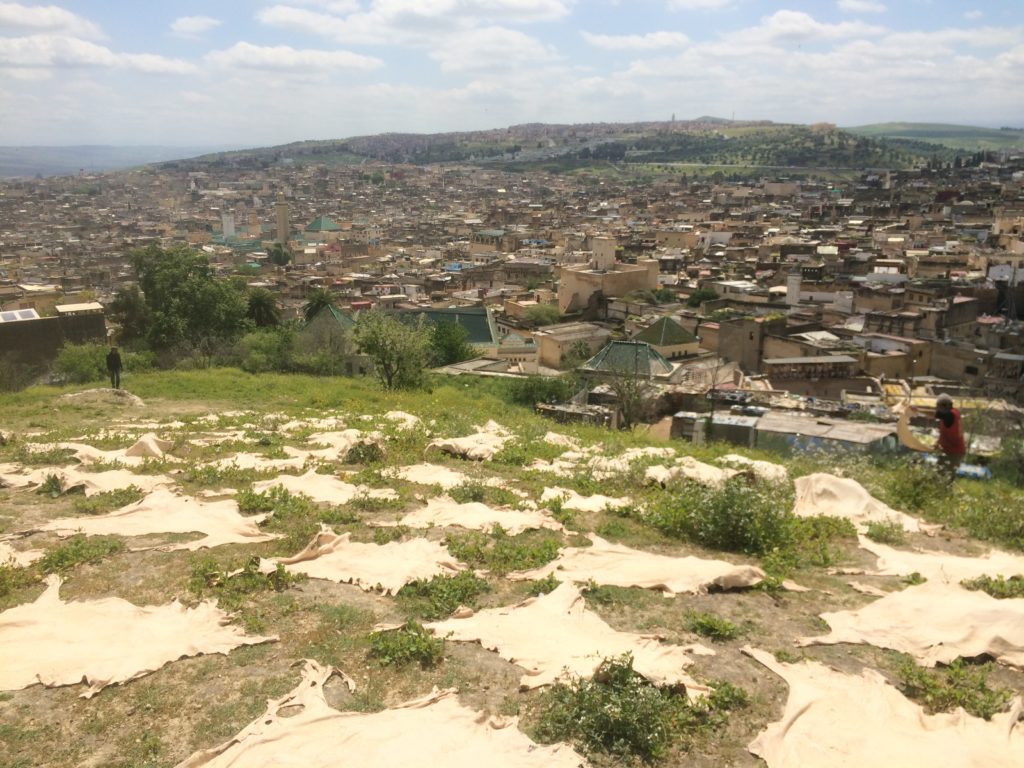
Hides left to dry on a slope overlooking the medina (Photo: Andrea Gambaro)
Just outside the walls, Borj Nord and the Merenid Tombs provide two of the best panoramic views over the medina. The former is the northern fortress of Fez (today the Museum of Arms), while the latter are what remains of once-splendid funeral monuments dating back to the 14th century.
Outside the old town
If walking is the only way to move around the medina, taxis are the best option outside the walls. The red ‘petit taxis’ cover short distances, while the white ones are for longer rides (e.g. to and from the airport).
Jnan Sbil gardens are located 500 meters east of Bab Bou Jeloud. They were originally part of the Royal Palace and have been recently restored with new pathways and fountains, providing a refreshing change of setting from the crowded medina.
The main entrance to the Royal Palace stands on the northern side of Place des Alaouites. Unfortunately, the 80 hectares covered by the palace are not open to visitors, but the stunningly-decorated gates make for an imposing sight.
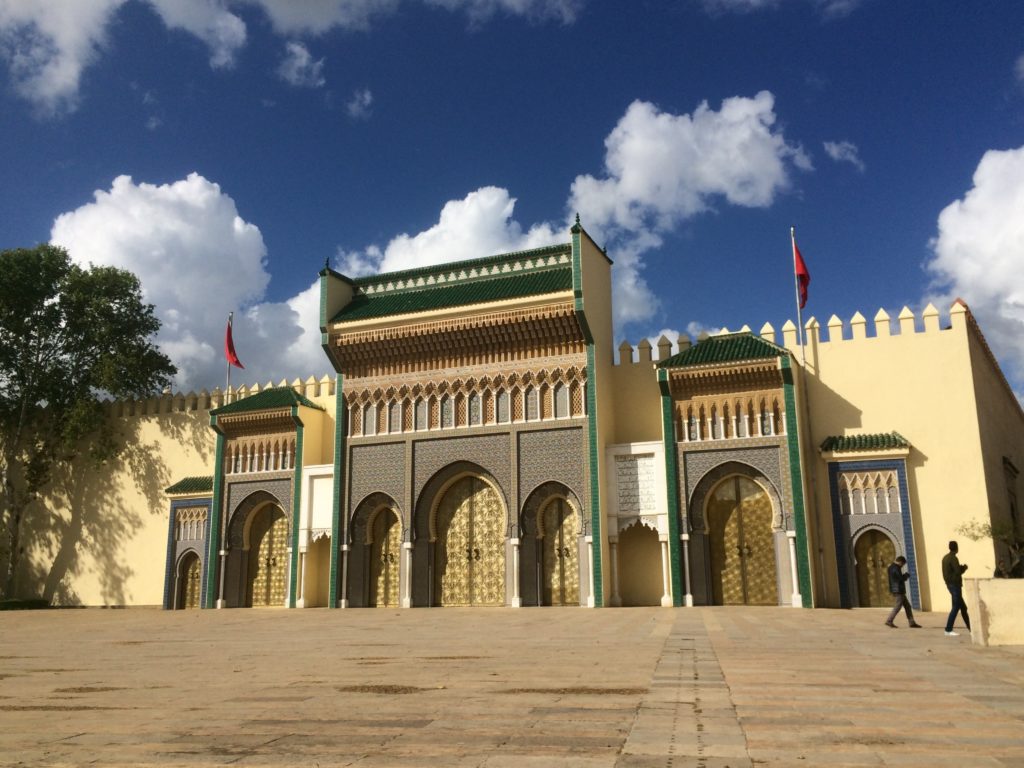
The Royal Palace seen from Place des Alaouites (Photo: Andrea Gambaro)
Located between Fes El Bali and the new city, the Mellah is the oldest Jewish quarter in Morocco, built in the 15th century during the Merinds dynasty. If the Jewish community that once lived here left decades ago, the buildings still show peculiar features which are not found elsewhere in Fez. Ibn Danan Synagogue, the Jewish cemetery and Rue de Mérinides are some of the main attractions in this area.
The Nouvelle Ville (new city) is what remains of the French protectorate that lasted from 1912 to 1955. Most tourists avoid this area altogether, but the modern urban landscape provides an interesting contrast with the old town. Architecture enthusiasts can seek out Art Deco buildings such as Café de la Renaissance, the Grand Hôtel, the Cinéma Bijou and the Rex Cinema, while modern restaurants, hotels and shopping centres (Borj Fez) are among the area’s attractions.
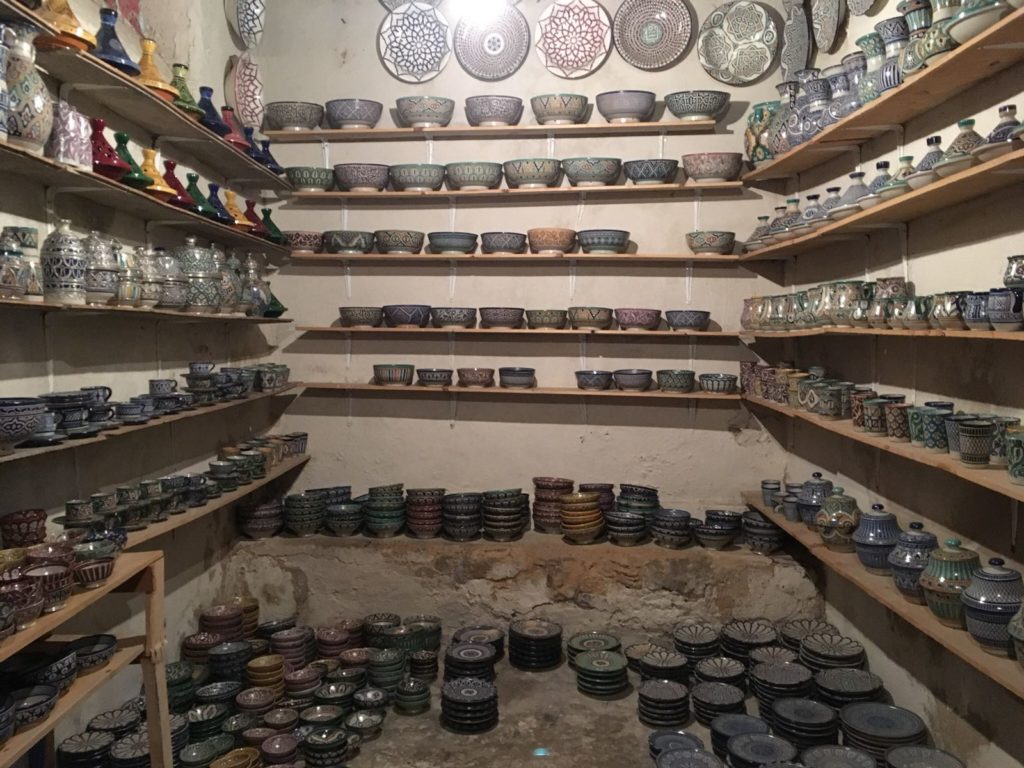
A dead end in a maze-like pottery shop of the medina. (Photo: Aina Pomar)
Accommodation
Dar Seffarine (14 Derb Sbaa Louyate, Fez 30020) is a medieval palace recently brought back to its previous splendour. A luminous courtyard, soaring columns, cedar doors, carved plasterwork and zellige mosaics put together an example of Moorish architecture at its best, striking a perfect balance between opulent décor and laid-back modern minimalism. The seven rooms available are spacious and true to the architectural style (don’t expect locks or window panes). In the rooftop dining room, guests sit around a big table and share communal dinners and breakfasts. Dar Seffarine provides the authentic feeling of a local guest house, just a few turns away from some of the medina’s busiest corners.
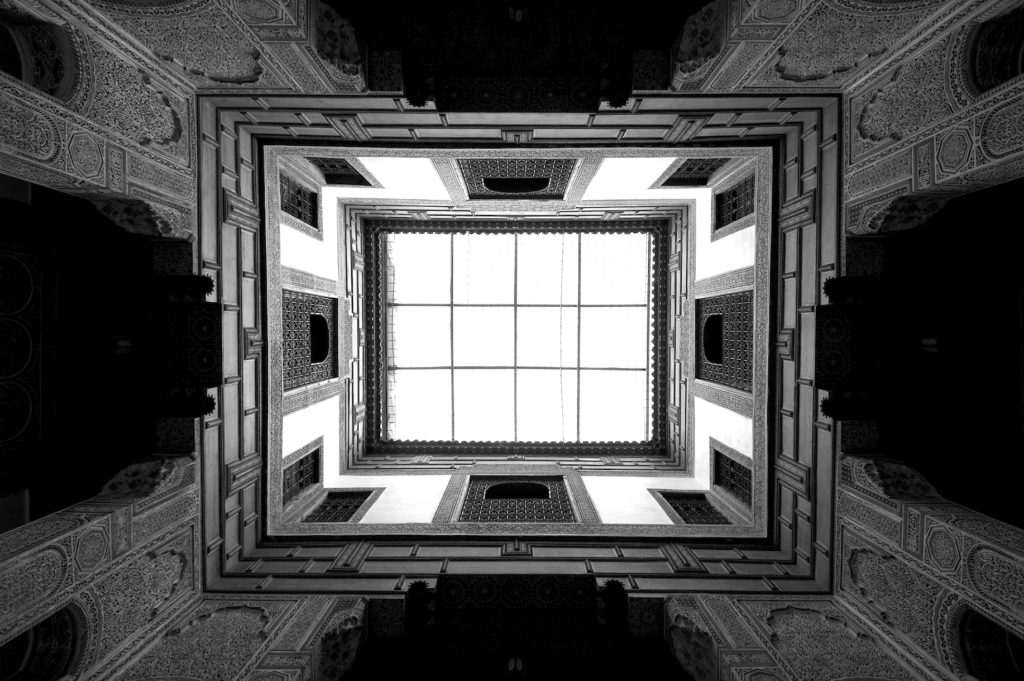
Dar Seffarine’s courtyard (Photo: Dar Seffarine)
In an elegant and relaxed setting, Riad Laaroussa (3 Derb Bechara, Fez) seeks to provide a tranquil stay surrounded by all the comforts of Moroccan hospitality. Spacious rooms and suites still feature the original décor of this 17th century palace, while the facilities include a panoramic terrace, a courtyard shaded by orange trees, a heated pool and large salons equipped with fireplaces. Traditional food is served at lunch and dinner, and informal cooking classes explore the secrets of Fassi cuisine. This riad also offers an authentic Moroccan spa experience. Located in the middle of the medina, Riad Laaroussa is committed to responsible tourism, sustainability and community-driven initiatives.
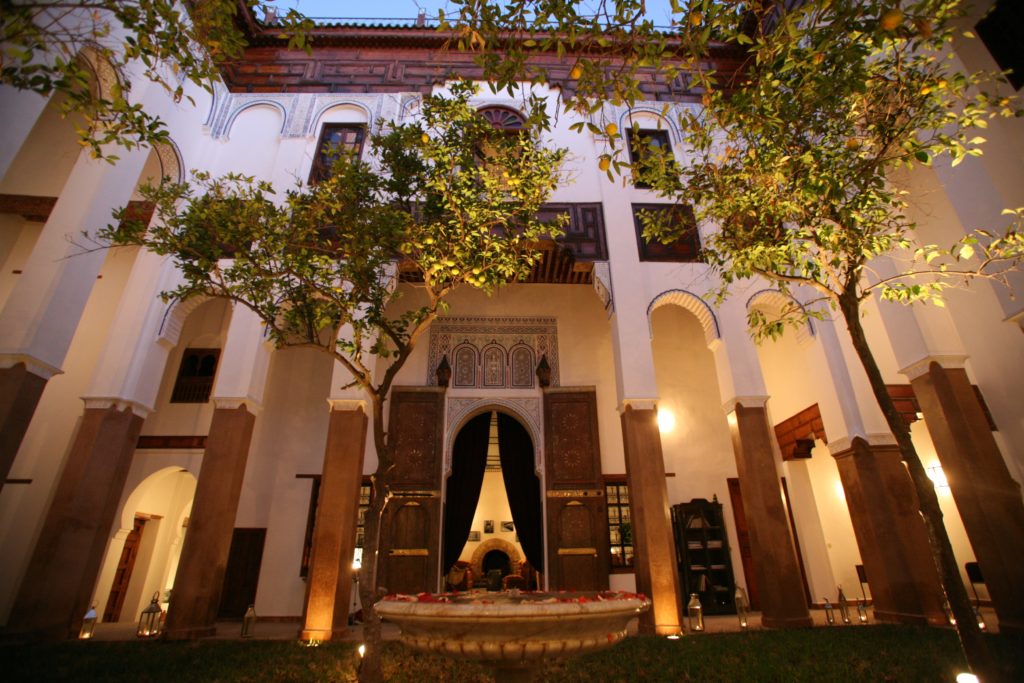
An orange tree shades the courtyard at Riad Laaroussa (Photo: Riad Laaroussa)
Riad Anata (Derb El-Hamia, Fez Boulemane 30200) brings together an Andalucian townhouse and a traditional Moroccan riad. Casual-chic décor, a light contemporary touch and intimate settings create a young and cosy atmosphere. Each of the five rooms has its own style and mood, while breakfast and dinner are served either on the rooftop terrace or in the central patio. The chef’s cooking classes include shopping at the medina’s markets.
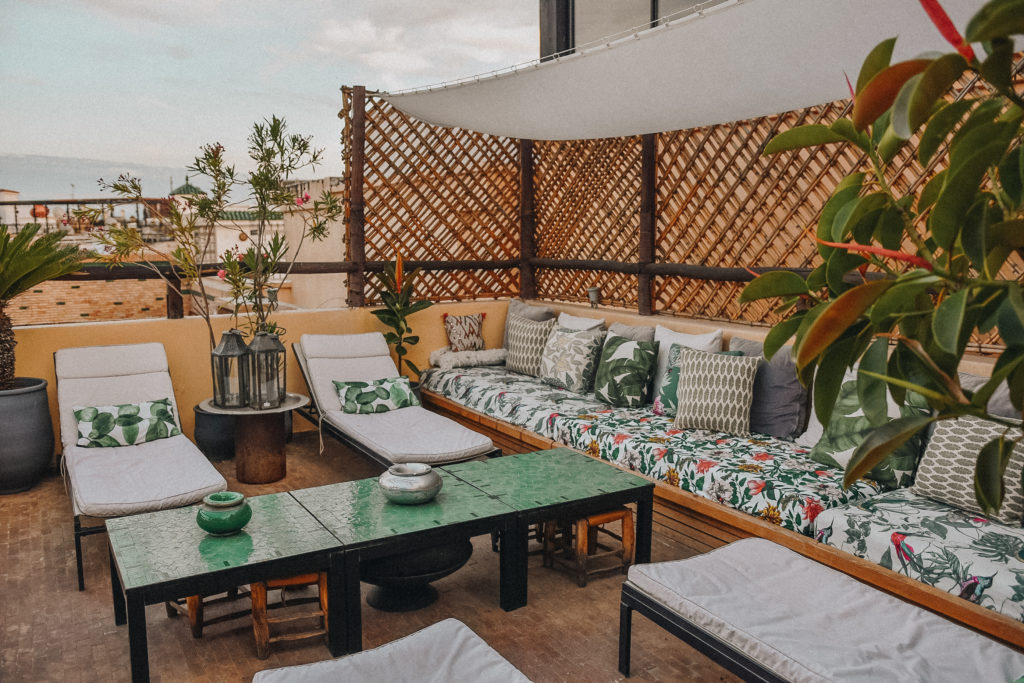
Riad Anata’s rooftop terrace (Photo: Laugh Of An Artist)
Named after the descendants of Fez’s founder, Riad Idrissy (13 Derb Idrissy, Fez 30110) combines the traditional feel of a 400-year-old palace with modern comforts and a friendly service. The interiors reflect the riad’s evolution over the years, while each room is individually furnished and decorated to provide five different settings to choose from. The largest room sits on top of the house, overlooking the communal terrace and the whole medina. Other common areas are the salon and the courtyard, while the garden is home to one of Fez’s most acclaimed new restaurants (see below).
Restaurants and cafes
The Ruined Garden (15 Derb Idrissy Sidi Ahmed Chaoui, Fez 30110) is the restoration project of an old merchant house turned ruin turned rubbish dump. Today, it’s Riad Idrissy’s beautiful garden and restaurant, open to the public from lunch to dinner. The menu features modern Moroccan dishes, tapas, street food, desserts and daily specials. Some elaborate Fez specialities need to be ordered in advance, such as 7-hour lamb ‘Mechwi’, Sephardic saffron chicken and pigeon B’stella (a typical filo pastry pie). The cooking classes available are focused on bread making and couscous rolling, and include visits to the local community oven.
Café Clock (7 Derb El Magana, Fez 30000) is a multi-storey eclectic space ideal for relaxing over a cup of mint tea as well as for meeting fellow travellers to share stories with. It is also popular with young locals and expats, perhaps attracted by the signature camel burger. The rest of the menu features an alluring and unfussy range of breakfasts, snacks, Moroccan dishes and desserts, providing options for any time of the day. What’s more, the agenda is filled with cultural events and initiatives, including movie nights, gnawa music at sunset, workshops and storytelling. It’s a prominent representative of the young and innovative face of the medina.
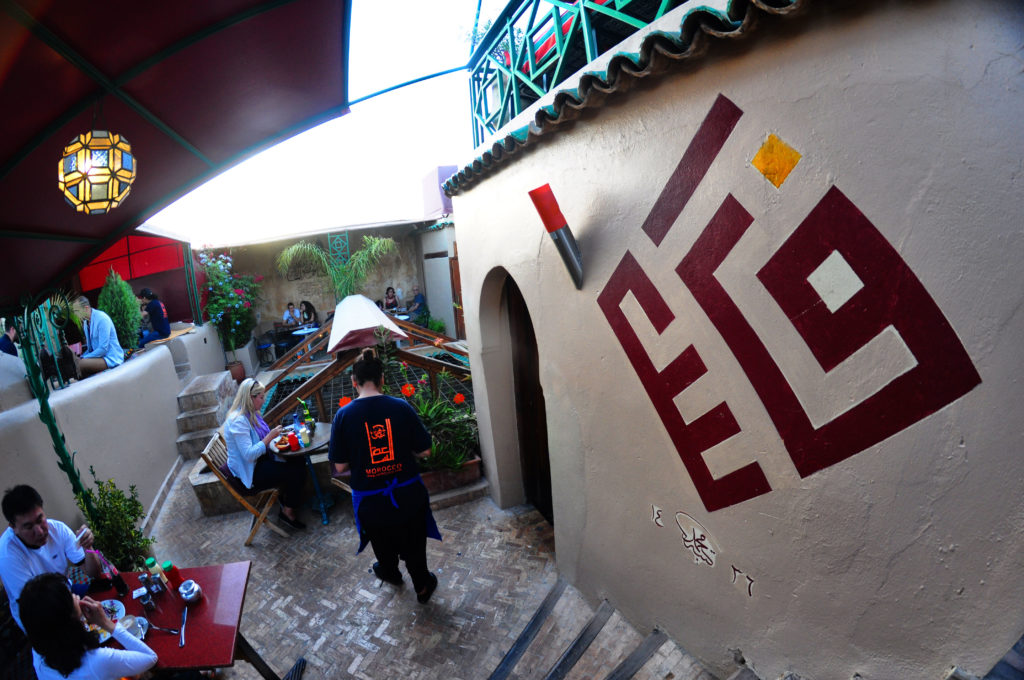
Café Clock has a branch in Fez and one in Marrakech (Photo: Café Clock)
At Nur (7 Zkak Rouah, Fez 30110), chef Najat Kaanache gives a contemporary and refined upgrade to the Moroccan cuisine. After growing up in the north of Spain and gaining experience at famed restaurants in Europe and the US, she returned to Morocco to turn her ancestors’ recipes into haute-cuisine creations. She offers an improvisational tasting menu (minimum two-hour long) designed around a daily selection of products found in the medina’s markets, served in a modern and chic environment. Prices are above local standards, but fully justified by the fine dining experience.
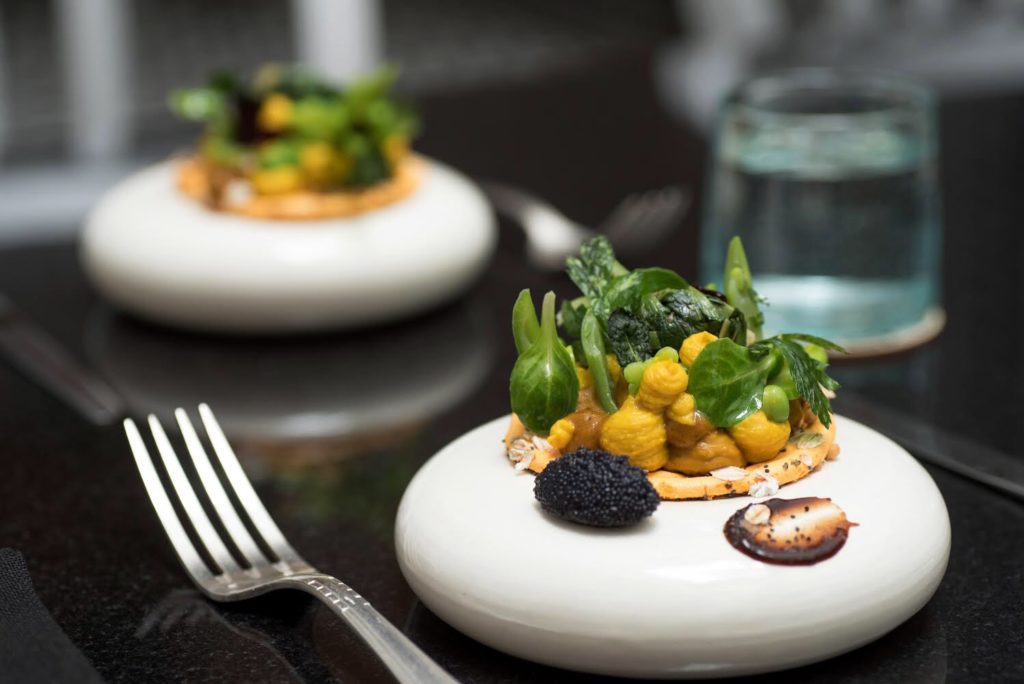
Moroccan food is given a classy makeover at Nur (Photo: Nur)
Another high-end restaurant, La Maison Bleue (2 Place Batha, Fez 30206) prepares recipes which have been handed down through the El Abbadi family for centuries. This palace was built in 1915 by Sidi Mohammed El Abbadi, a prominent judge and astronomer, and later opened to the public by his grandchildren. Today, guests are offered fine Moroccan dishes as gnawa musicians and performers accompany the culinary experience, while an assorted list of wines and cocktails is also available. A hideaway of opulent and friendly hospitality in the medina of Fez, La Maison Bleue is also a hotel and a traditional spa.
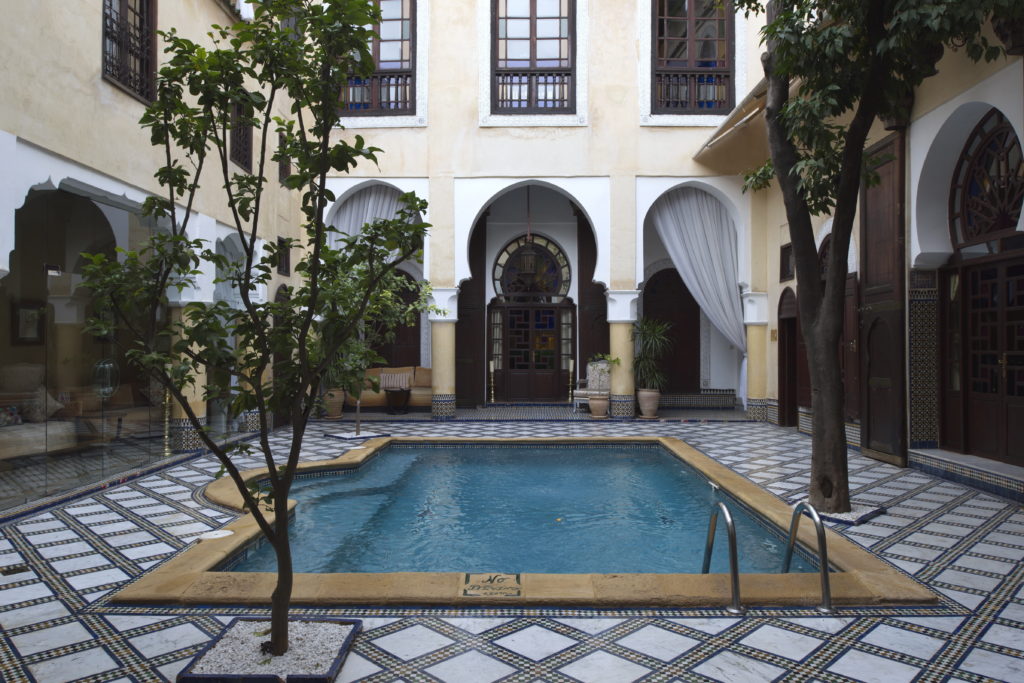
Le Maison Bleue (Photo: Stephan Soudiere)
Shopping
The medina’s rich and colourful souks provide lots of shopping temptations. Many are still separated by products, as they have been for centuries: the henna souk is located at the bottom of Rue Talaa Kebira, leather goods are concentrated around the Chaouwara tanneries, woodwork populates the streets surrounding Nejjarine Square and the metalworkers’ clanging resounds around Place Seffarine. Other typical products sold in the souks are carpets, spices, musical instruments, perfumes, silverware and pottery.
The quality doesn’t always live up to the fame of Fez’s artisanal heritage, so it’s recommendable to take some time to examine and compare items, rather than rush into a purchase. It is also good to keep in mind that haggling is part of the local culture, and is often the only way to make a good deal. However, the markets are not the only options for shopping in Fez.
Fashion and Thai food is certainly an unprecedented combination in the medina. Designer and chef Moi Anan launched his concept store in 2014, Maison Moi Anan (30 Zkak Lma Hay Ben Safi Kebira, Fez 30000), which was created in Bangkok a few years back. International boutiques and prestigious catwalks have featured his fashion line, inspired by a wide range of aspects of the Thai culture and modulated to a formal Western tone. After moving to Fez, his garments also show a hint of Moroccan influence, and so does his refined Thai cuisine.
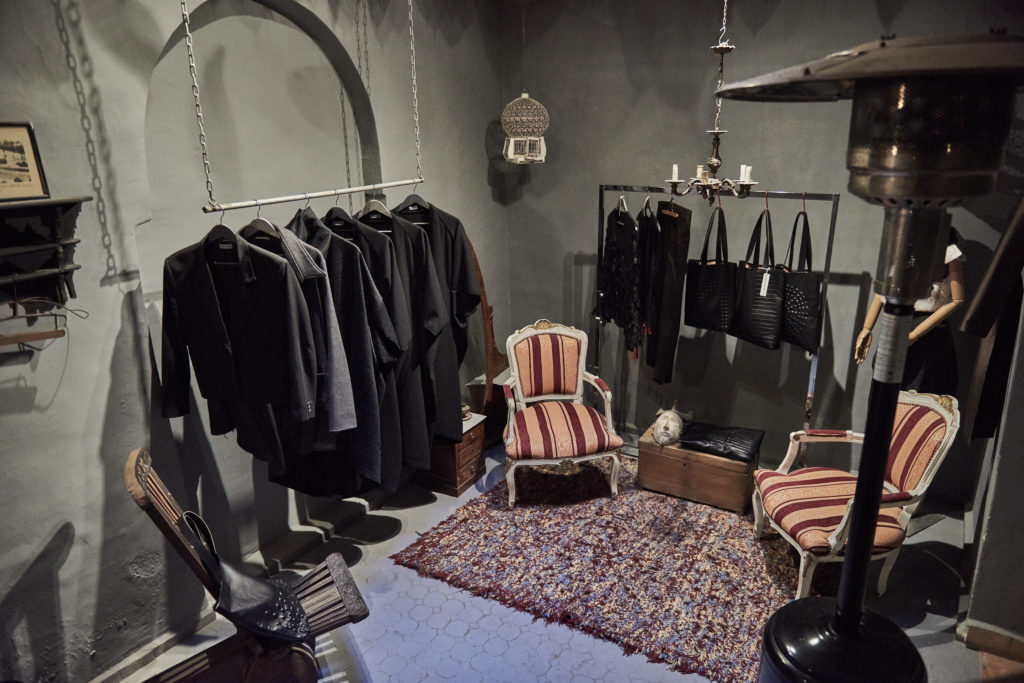
Moi Anan’s fashion line (Photo: Maison Moi Anan)
A 5-minute drive from Bab Ftouh, the south-eastern gate of the medina, Art Naji (20 Quartier Industriel Ain Nokbi, Fez 30120) is a pottery factory open to the public. Here, local master artisans can be seen modelling clay, painting ceramics or chiselling away to create mosaic tiles that will form intricate zellige patterns. At the end of the free tour, a showroom displays a vast assortment of plates, saucers, vases, bowls, cups and other items. Prices are higher than in the medina, but haggling is just as acceptable. Shipping for large purchases can be arranged.
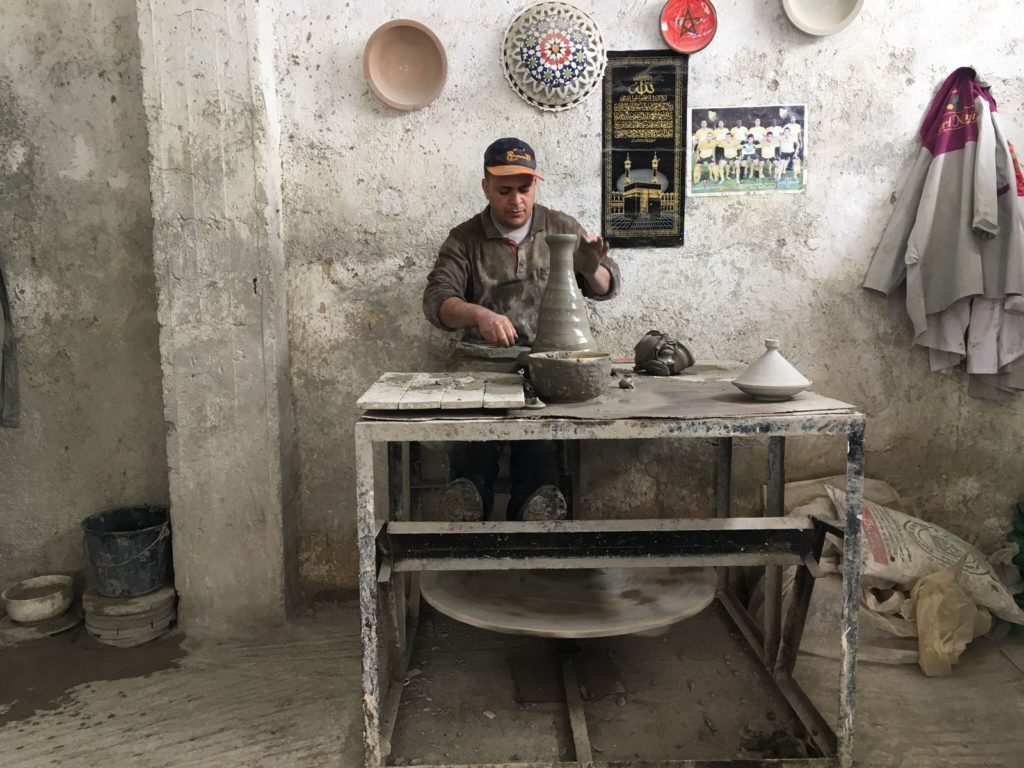
A live demonstration at Art Naji (Photo: Aina Pomar)
The shop is just a part of Le Jardin des Biehn (13 Akbat Sbaa, Fez 30100), but not one to be overlooked. Its collection of antique textiles includes embroidery from Fez and Rabat, Uzbek chapans, nomad robes and Touareg djellabas, reflecting the expertise of renowned collector Michel Biehn. Contemporary throws, bags, jewellery and accessories are featured in the shop, resulting from the collaboration between international designers and Fassi artisans. A gem in the middle of Fez’s medina, Le Jardin des Biehn is also a hotel, restaurant and spa.
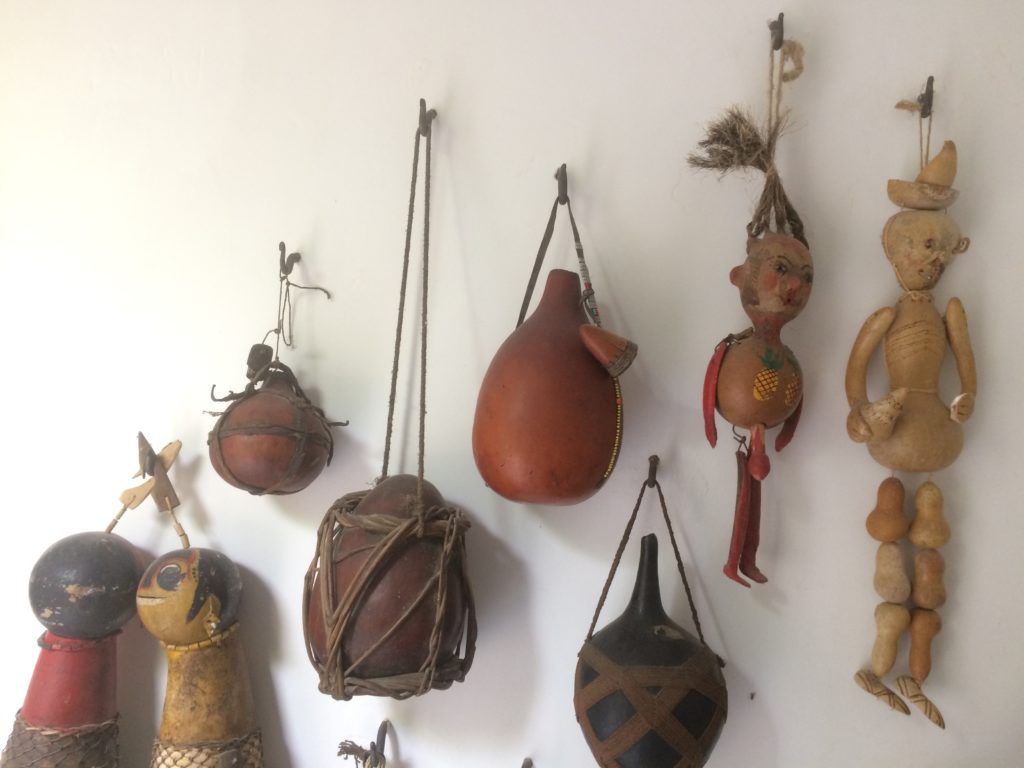
Michel Biehn’s secret gallery is a surprising collection (Photo: Andrea Gambaro)
Far away from the atmospheres of the medina, Borj Fez (Av. Allal Al Fassi, Fez 30000) is the Nouvelle Ville’s modern shopping mall. It hosts a range of international and local brands, providing a safe shopping option when nothing else does. The fun park will likely be the kids’ favourite attraction, while the mall’s cafes and restaurants stay open until past midnight during summer.
Spa
The Moroccan hammam is a local typical experience. Most riads and hotels offer this ritual as part of their well-being treatments, while public bathhouses are scattered across the medina. Skin scrubbing is the core of the ritual, preceded and followed by treatments which relax and revitalise the whole body and mind.
Les Bains Amani (12 Derb El Miter, Fez 30000) has a candle-lit luxurious hammam complete with separate exfoliation room, showers and relaxation area, where the benefits of this traditional ritual can be explored fully. The various treatments available last from 30 minutes to over an hour, the longest of which includes bathing with sea salt crystals, light and vigorous body scrubbing, and an optional clay hair mask. The spa is part of Palais Amani, a riad offering exclusive rooms, refined Moroccan food and a rooftop bar.
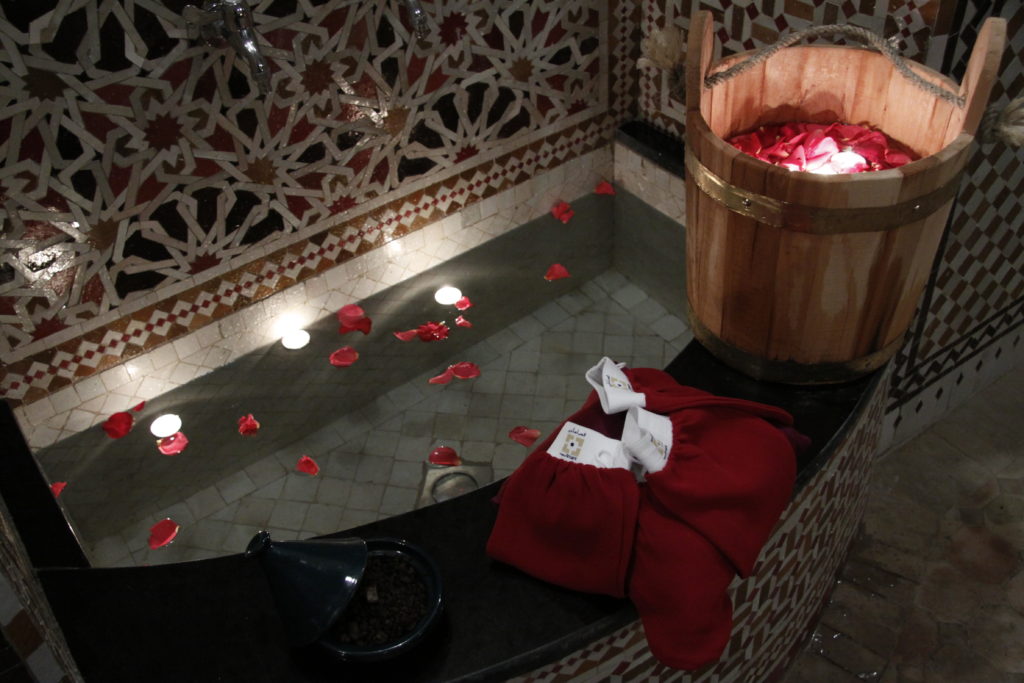
Les Bains Amani’s hammam fountain (Photo: Palais Amani)
Four hundred sq. meters of Palais Faraj (Bab Ziat, Fez 30000) are dedicated to wellness, as the Oriental spa provides an elegant setting for leisure and relaxation. This includes a traditional hammam with black soap, body scrubs, massages, a hair and beauty salon, and a tea room around a patio. All are accompanied by a range of natural cosmetics such as orange blossom water, argan oil and black soap. This five-star hotel on the outskirts of the medina also offers suite rooms, bars and classy restaurants.
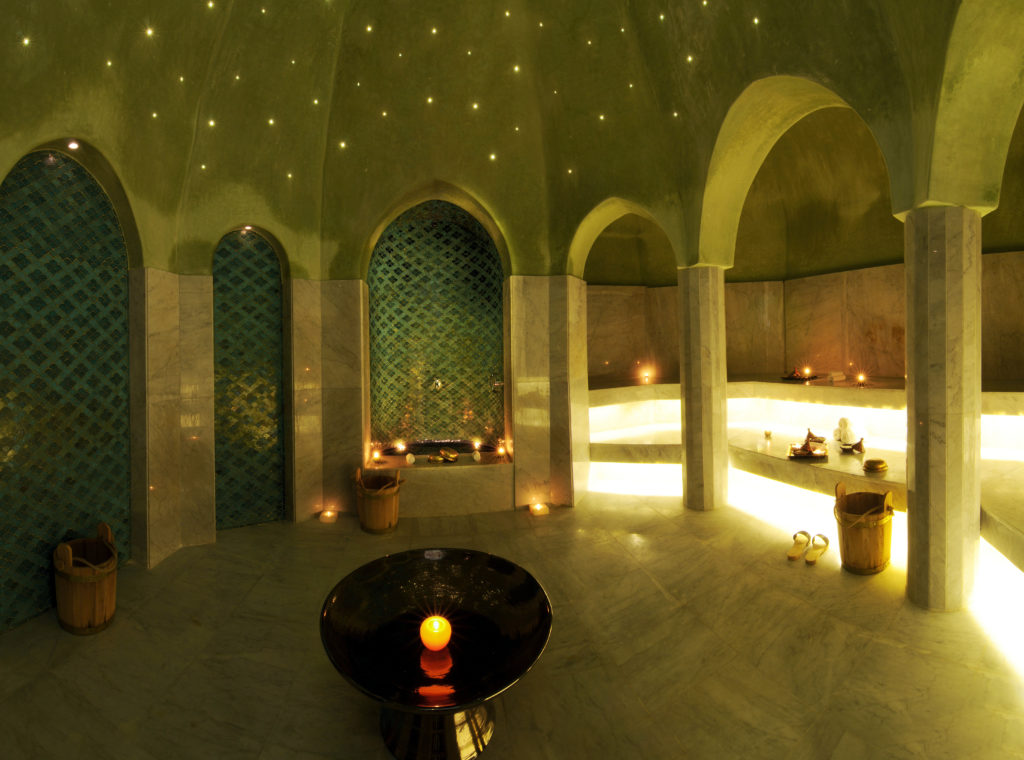
Palais Faraj’s spa (Photo: Palais Faraj)
Riad Fès (5 Derb Zerbtana, Fez 30110) hosts a Cinq Mondes spa which offers the tranquillity of the Moroccan hammam in an opulent and comfortable environment. The spa’s sensorial journeys include a thoughtful selection of treatments, massages and traditional formulas. A modern sauna is also part of the well-being options, and they can be combined with a luxurious stay and fine dining at the riad.
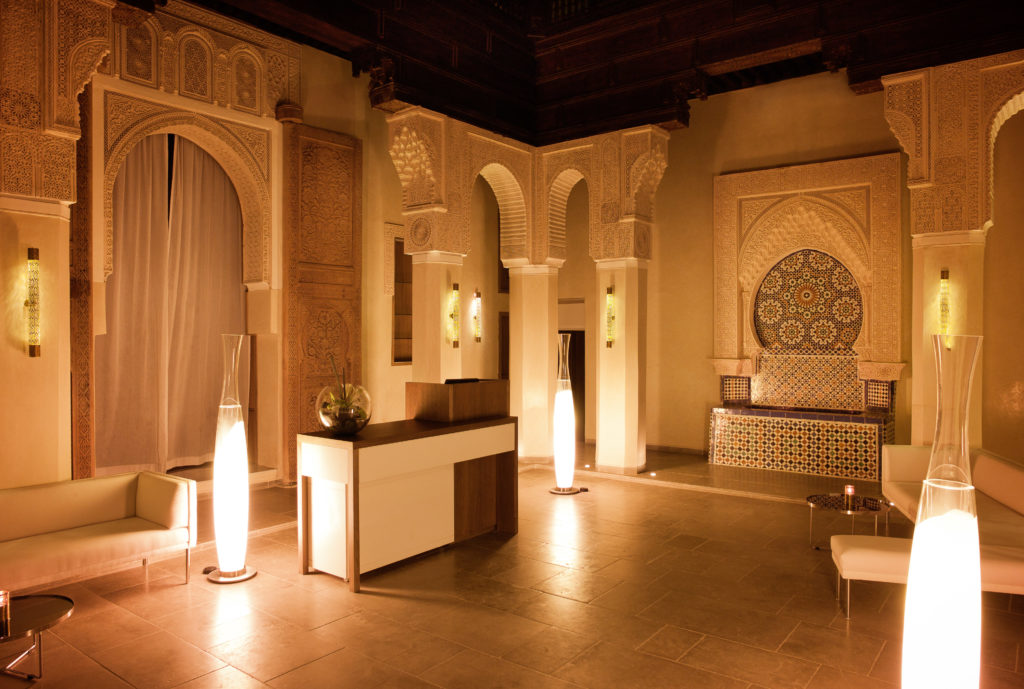
Riad Fès hosts a Cinq Mondes spa (Photo: Riad Fès)
The public hammams might be less chic than those described above, but sharing the ritual with locals is certainly a more authentic experience. Among many other options, two popular hammams located in the medina are Aïn Azleten (Rue Talaa Kebira, opposite the car park) and Hammam Mernissi (Rue Talaa Shira, around the corner from Bab Bou Jeloud).